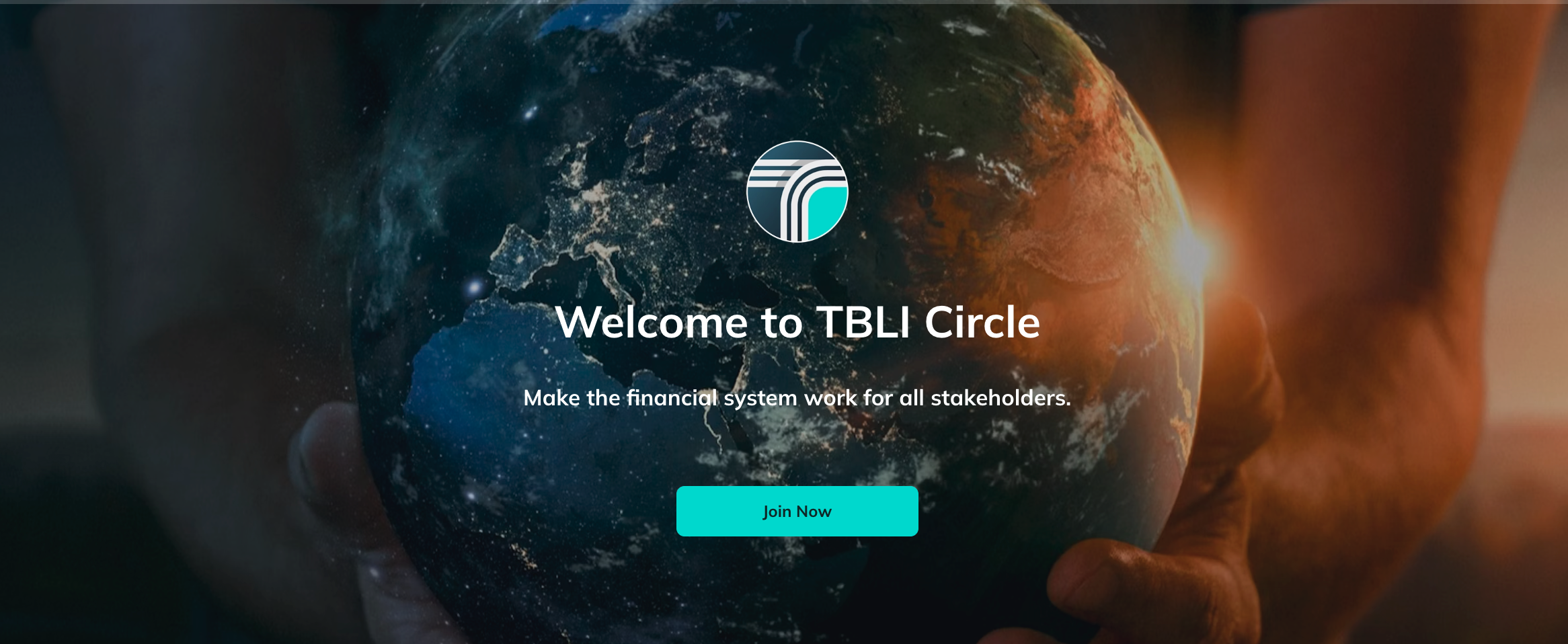
Your weekly guide to Sustainable Investment
TBLI Capital Connect Client Highlight
Carbon Asset Solutions (CAS)
Bringing Measurable Soil Carbon Markets to Scale
Meet Carbon Asset Solutions (CAS)—a climate tech innovator unlocking value from soil carbon through patented, satellite-calibrated measurement technology.
CAS enables farmers and landowners to generate verified carbon credits by improving soil health—without the need for expensive sampling or guesswork. Its proprietary system provides scalable, verifiable, and low-cost measurement of carbon sequestration at the field level.
The result? High-integrity, nature-based carbon credits with traceability, transparency, and real impact.
Contact for more info on CAS: robert@tbliadvisorygroup.com
Are you interested in engaging TBLI for our Capital Connect services? Book a call here
TBLI Radical Truth Podcast
Creating Impact Through Youth Led Social Entrepreneurship /w Eric Dawson

The world faces seismic shifts in how people work, learn, and connect. Youth, who represent majorities in many countries, are at the forefront of this change. Youth unemployment, disconnection, and isolation threaten our collective future, yet the 1.8 billion young people globally are an untapped resource eager to tackle entrenched problems—though few have access to tools, mentors, and resources.
For over 30 years, Dr. Eric Dawson has led efforts at the intersection of youth culture, social innovation, and brands, authoring influential research on human development and youth-led social innovation globally. He is CEO of RIVET, the first consumer-facing social impact brand leveraging Gen Z's consumer power to fund youth-led innovations through micro-financing, aiming to invest in over a million initiatives by 2035.
What will you learn in this podcast:
- The unique role young people play in driving social innovation
- Innovative models of financing impact
- Ways in which we can all contribute to a growing global movement of young change makers
Upcoming TBLI Virtual Mixers

Connect with likeminded individuals & grow your network
The TBLI Virtual Mixer (Networking) is where values-led professionals connect — no pitches, no panels, just purpose.
📅 Every last Friday at 16:00 CET
👉 Register here
The Financial Parasite Problem: Why Most Finance and Consulting "Professionals" Are Just Dressed-Up Leeches

By Robert Rubinstein
Let's cut through the bs, shall we? I've spent decades in finance, and I'm here to tell you something that'll make your compliance department sweat: most financial and consulting professionals are nothing more than sophisticated parasites in expensive suits.
You know the type. They slide into your LinkedIn DMs with laser precision, armed with buzzwords like "synergy" and "value-add." Their enthusiasm burns bright as a supernova—right up until they realize you can't write them a check or connect them to someone who can or you did deliver on their ask. Then? Poof. They vanish faster than your 401k during a market crash.
The Great Financial Ghosting
Here's how it works: These financial vampires identify their target (you), deploy their charm offensive (coffee meetings, lunch invitations, "I'd love to pick your brain" sessions), extract what they need (your contacts, your insights, your time), and then disappear into the ether like they never existed. No follow-up. No thank you. No acknowledgment that you just gave them two hours of your life you'll never get back.
It's not networking—it's extraction. And it's unacceptable.
I watched a "wealth management specialist" spend three months courting a small business owner, promising customized solutions and personalized service. The moment he discovered the guy's net worth was south of his minimum threshold? Radio silence. The business owner kept calling, wondering if he'd said something wrong. That's not professional service—that's emotional manipulation with a Series 7 license.
The Time Vampire Economy
These people have turned time-wasting into an art form. They'll gladly consume your hours like a black hole consumes light, but try getting five minutes of their attention once they've determined you're not immediately profitable. They act like hawks circling to pounce. No time for you.
Here's what really pisses me off: they're not just wasting your time—they're devaluing the entire profession. When you treat people like ATMs instead of human beings, when you ghost them the moment they're not immediately useful, you're not building a business. You're running a con game with business cards.
The Radical Truth About Financial "Relationships"
Let me tell you the truth that makes everyone uncomfortable: most financial relationships are transactional BS masquerading as genuine connection. These people don't want to know you—they want to know your bank balance or what is there to extract (knowledge, connections, money). They don't care about your goals—they care about their upside. They're not building relationships—they're building extraction pipelines.
And the worst part? They've convinced themselves they're providing value while they're busy hoovering up yours.
I've had strategy consultants contact me constantly to "share experiences" , which translates into how can they suck power point slides out of your brain to repackage and sell. Oh yeah, then they ghost you. I've watched investment advisors wine and dine prospects for weeks, then ghost them completely when they discover the money's tied up in trusts they can't touch.
This isn't relationship building—it's relationship strip-mining.
The Professional Parasite Playbook
Here's their standard operating procedure:
- Identify the target with apparent wealth/connections
- Deploy artificial charm and fake interest
- Extract maximum value (contacts, information, time)
- Disappear without explanation or courtesy
- Repeat with the next victim
Read full article
What’s likely to survive from Biden’s climate law? The controversial stuff.

Most of the incentives left off the chopping block are those favored by oil and gas companies.
Dig down about a mile or two in parts of the United States and you’ll start to see the remains of an ancient ocean. The shells of long dead sea creatures are compressed into white limestone, surrounding brine aquifers with a higher salt content than the Atlantic Ocean.
Last summer, Exxon Mobil sponsored week-long camps to teach grade school students from Texas, Louisiana, and Mississippi about the virtues of these aquifers, specifically their ability to serve as carbon capture and sequestration wells, where oil, gas, and heavy industry can bury harmful emissions deep underground. In one exercise, students were given 20 minutes to build a model reservoir out of vegetable oil, Play-Doh, pasta, and uncooked beans. Whoever could keep the most vegetable oil (meant to represent liquified carbon dioxide) in their aquifer, won.
This kind of down-home carbon capture boosterism is a relatively new development for the oil and gas giant. Over recent years, Exxon Mobil and other fossil fuel companies have spent millions lobbying for government support of what they see as industry-friendly green technology, most prominently carbon capture and storage, which many scientists and environmental activists have argued is ineffective and distracts from eliminating fossil fuel operations in the first place. According to Exxon’s website, it’s evidence that they are leading “the biggest energy transition in history.”
Now that Congress has turned its attention to rolling back government spending on renewable energy, it appears that most of the climate “solutions” being left off the chopping block are the ones favored by carbon-intensive companies like Exxon. Corporate tax breaks for carbon capture and storage, for instance, were one of the few things left untouched when House Republicans passed a budget bill on May 22 that effectively gutted the Inflation Reduction Act, or IRA, the Biden administration’s signature climate legislation. What remained of the IRA’s clean energy tax credits were incentives for nuclear, so-called clean fuels like ethanol, and carbon capture. When the IRA was passed in 2022, there was immediate backlash against the provisions for carbon capture.
“Essentially, we, the taxpayers, are subsidizing a private sewer system for oil and gas,” said Sandra Steingraber, a senior scientist at the nonprofit Science and Environmental Health Network.
The tax credits for nuclear power plants, which produce energy without emitting greenhouse gases, are meant to spur what President Donald Trump hopes will be an “energy renaissance,” bolstered by a flurry of pro-nuclear executive orders he issued a day after the budget bill cleared the House. Projects will be able to use the tax credits if they begin construction by 2031; wind and solar companies, however, will lose access to tax credits unless they begin construction within 60 days of Trump signing the bill, and are fully up and running by 2028.
That the carbon capture tax credit was never in danger of being revoked is a testament to its importance to the oil and gas industry, said Jim Walsh, the policy director at the nonprofit Food and Water Watch. “The major beneficiaries of these tax credits are oil and gas companies and big agricultural interests.”
The carbon capture tax credit was first established in 2008, but the subsidies were more than doubled when it was tacked on to the IRA in order to get former senator Joe Manchin of West Virginia’s vote. Companies now receive $60 for every ton of CO2 captured and used to drive oil out of the ground (a process known as “enhanced oil recovery”) and up to $85 for a ton of CO2 that is permanently stored. As roughly 60 percent of captured C02 in the United States is used for enhanced oil recovery, detractors see the tax credit as something of a devil’s bargain, a provision that props up an industry at taxpayer expense.
Ethiopia Invests Big in Restoring Degraded Land

By Tsion Issayas and Yigremachew Seyoum Lemma - wri.org
Amid global climate-action promises, many countries have pledged to restore degraded land and expand tree cover. Ethiopia has taken that commitment one step further.
In a landmark move, Ethiopia's government launched the Green Legacy and Landscape Restoration Special Fund, allocating 0.5% to 1% of its annual federal budget — about $40 to $80 million — to restoring degraded landscapes. Approved by the House of Peoples’ Representatives on Dec. 24, 2024, the fund positions Ethiopia as a pioneer in using federal resources to advance large-scale restoration, setting a powerful precedent for other nations across the world to follow.
The fund forms part of Ethiopia’s broader Green Legacy Initiative (GLI), a national program launched in 2019 to combat environmental degradation and build a greener, more climate-resilient country. By establishing a dedicated financing mechanism, the country aims to scale up its restoration efforts with sustainable public investment.
The GLI recognizes that land restoration is more than just planting trees — it can improve food security, enhance air quality, increase water availability, boost climate resilience and create jobs. Ethiopia’s approach offers a promising model for how stable public financing can drive large-scale restoration in climate-vulnerable countries.
Ethiopia Builds on Its Reputation as a Restoration Leader
Ethiopia has emerged as a global leader in landscape restoration in recent years, driving change through bold action and ambitious targets. Through its GLI, the country exceeded its initial goals by planting over 25 billion trees in just four years, including a reported 350 million trees in a single day in August 2019, a feat believed to have set an unofficial new world record.
To date, the initiative has planted more than 32 billion seedlings, with a goal of reaching 50 billion trees by 2030. It has already generated significant social benefits, including the creation of more than 767,000 jobs in areas such as nursery management, seedling production, agroforestry and sustainable land management throughout the country — many of them for women and youth.
Ethiopia has also made the most ambitious commitment under the African Forest Landscape Initiative AFR100, pledging to restore 22 million hectares (84,942 square miles) of degraded land. This aligns with its broader international commitments under the Bonn Challenge and the New York Declaration on Forests, both of which aim to combat deforestation and promote large-scale land restoration.
Restoration Brings a Host of Benefits
After decades of severe deforestation, Ethiopia is beginning to reverse forest and land degradation through coordinated national efforts. Between 2013 and 2023, the annual deforestation rate fell from 92,000 hectares (355 square miles) to 27,703 hectares (107 square miles), according to a report. Meanwhile, forest cover increased from 15.5% in 2013 to 23.6% during the same period.
But there’s still much work to do. Between 2000 and 2013, Ethiopia lost an average of 92,000 hectares (355 square miles) of forest each year. A growing population and rising demand for land continue to fuel deforestation. Land degradation costs Ethiopia an estimated $4.3 billion per year due to reduced agricultural productivity and loss of ecosystem services such as food production and water availability. The long-term economic losses from inaction are estimated to be four times higher than the cost of restoring degraded land.
Ethiopia is among the world’s most climate-vulnerable nations. Increasingly severe droughts, floods and landslides have taken a devastating toll in the country. In 2024, landslides in the southern Gofa region caused by heavy rains were the deadliest natural disaster in the history of the country, killing at least 250 people and displacing more than 14,000.
Degraded and deforested landscapes increase the risk of climate-related disasters. Events like the Gofa landslides underscore the urgency for Ethiopia to build climate resilience, and land restoration is increasingly recognized as part of the solution.
Calls for Drax to be forced to fully disclose its biomass sourcing

By: Fiona Harvey and Jillian Ambrose
Campaigners say the publication of key KPMG report must be a condition to MPs extending subsidies scheme
The owner of the Drax wood-burning power station should be forced to disclose full details of its tree consumption, campaigners have argued, as MPs review the billions in renewables subsidies the North Yorkshire plant receives.
A delegated legislation committee will decide on Monday whether to pass the government’s plans to extend billpayer-funded subsidies to the country’s biomass power generators, of which Drax is by far the biggest.
Green campaigners said a condition of any extension should be that Drax published a key report by KPMG into its operations and sourcing. Reports by the auditor have been provided to the government and the energy regulator Ofgem but not the public.
Ofgem has said KPMG shows Drax has not breached rules on sourcing trees for burning from environmentally sustainable forests.
However, in separate incidents, Drax had been found to have supplied inaccurate data for subsidies in the past, leading to a £25m fine. Media investigations also found Drax using wood from old-growth forests in the US.
Drax is expected to receive more than £10bn in renewable energy subsidies between 2012 and 2027, the current regime period, according to the thinktank Ember.
Kingsmill Bond, an energy strategist at Ember, said: “Burning trees for electricity is extremely inefficient and expensive, and is not effective at mitigating climate change.
“The collapse in the price of solar, wind and batteries in the last five years means that burning trees for electricity is now an obsolete technology. Before we pour any more subsidy into Drax, MPs need to see the KMPG report on where the wood has been coming from.”
Dale Vince, founder of Ecotricity, a green energy company, said: “If Drax don’t come clean about their operations, how can we trust them? They don’t deserve further public money.”
The government plans to halve the subsidies available for biomass power generation under a revised regime from 2027. MPs on the delegated legislation committee are expected to vote on Monday on the statutory instrument enabling this.
Almuth Ernsting, the co-director of the campaign group Biofuelwatch, said: “If those subsidies are approved, it would result in more carbon emissions, more destructive logging of wildlife-rich forests in the south-eastern US and elsewhere, and more pollution suffered by communities living next to pellet plants in that region – pollution which community activists have denounced as ‘environmental racism’.”
Mark Campanale, the founder of the Carbon Tracker Initiative, added: “At a time when renewables powered by wind, solar with back up batteries are growing exponentially around the world, it seems remarkable that the UK still needs to rely on dirty combustion like Drax to reach its climate targets. Instead of importing and burning wood, with all its associated emissions, the UK should be doubling down on natural sources of energy available to us, wind and solar.”
A spokesperson for Drax said: “In their investigation Ofgem found no evidence that our biomass failed to meet the sustainability criteria of the RO [renewable obligation] scheme, nor that the ROCs [renewable obligation certificates] we received for the renewable power we produced had been provided incorrectly.
“Their new statement on the reports we commissioned from KPMG, as well as the prior comments in a public accounts committee hearing by Ofgem’s director of audit and compliance, confirm that they reviewed these documents as part of their investigation and found no evidence within them that we were in breach of our sustainability obligations and therefore wrong to receive RO funding.”
The spokesperson added: “Drax provides secure renewable power to millions of homes and businesses when they need it, not just when the wind is blowing, or the sun is shining. The science underpinning biomass generation is supported by the world’s leading climate experts, including the UN’s Intergovernmental Panel on Climate Change and the UK’s Climate Change Committee.”
A spokesperson for the Department for Energy Security and Net Zero said: “We are halving the amount of support for Drax, saving money on people’s energy bills and contributing to our energy security. Drax will operate for less of the time under a clean power system and will need to use 100% sustainably sourced biomass, with not a penny of subsidy paid for anything less.”
The Guardian understands there would be substantial penalties for any breach of the sustainability criteria.
Can trade in soil carbon credits help farmers – and the climate?

By: Joanna Partridge - The Guardian
Regenerative agriculture has growth potential for the offsets market, but scientists question its green credentials
On a blustery spring day, Thomas Gent is walking through a field of winter wheat on his family’s farm, which straddles the Cambridgeshire and Lincolnshire border. Some of the green shoots reach his knees, while the ground between the plants is covered with clover.
Sinking a spade into the soil, Gent grins as he points to the freshly dug clod of earth on the blade. “Look at the root structure,” he says. “It rained 20mm last night. The water has drained down because the soil structure is in the right format.”
Unlike the vast majority of farmed fields in the UK, this one has not been ploughed for 17 years, ever since Gent’s family switched to regenerative agricultural methods designed to increase soil carbon stores.
Such practices are not just good for the environment; they are now becoming big business. Companies are springing up that evaluate existing carbon stocks in soil and track their improvement, allowing farmers to earn – and sell – carbon credits, which can provide them with an alternative income stream.
Cultivating a movement
Much of modern agriculture has damaged the earth’s soils through repeated cultivation of the same crops and use of fertilisers. Regenerative methods include: tilling the soil less or not at all; growing cover crops such as clover; reducing the use of ammonia-based fertiliser to restore soil health; and keeping organic matter in the soil to help crops grow and sequester carbon.
Back in 2008, when Thomas was just a boy, the Gent family were viewed as trailblazers for wanting to move away from conventional systems on their 800-hectare farm, where they grow cereals and other crops.
Such an approach remains rare in the sector, yet the now 27-year-old youngest Gent believes that the movement’s time has come.
Given that food systems produce a third of human-caused global greenhouse gas (GHG) emissions, he believes that regenerative agriculture has a significant role to play in tackling the climate crisis while benefiting farmers financially.
He also works for a Danish startup, Agreena, which aims to grow the regenerative movement as it develops what it describes as the “largest soil carbon programme in Europe”, building a model to produce credits that could be bought by companies for their climate change programmes.
A growing market
Agreena is one of a host of firms – including Soil Capital, Trinity Natural Capital Group and the largest global player, the US-based Indigo – who are trying to grab a slice of the voluntary carbon offsets market through soil carbon trading.
Research from the Organisation for Economic Co-operation and Development suggests that net soil carbon sequestration on agricultural land “could offset 4% of annual global human-induced GHG emissions over the rest of the century”.
However, even as the market grows rapidly, so does the scepticism around it. Much in the world of soil carbon is disputed, and scientists question whether regenerative practices actually increase the amount of carbon stored in soil, while others query the robustness of the data on which the market is based.
The total voluntary offsets market was valued at nearly $2bn (£1.6bn) at its peak in 2022. However, it is estimated to have dropped to $723m in 2023, following a series of scientific and media reports that found many offsetting schemes did little to mitigate the climate crisis and biodiversity loss.
Soil carbon projects are estimated to represent a small but growing part of the voluntary carbon market, according to Tommy Ricketts, co-founder of the carbon credit rating agency BeZero Carbon.
“If you include peatland, we estimate the value of soil credits issued to the market is upwards of $100m, or roughly 5%-10% of the global traded market,” Ricketts says.
https://mail.tbligroup.com/emailapp/index.php/lists/vr9326mjcm0e8/unsubscribe
